It’s been called Kyiv’s “plan B:” a $520-million, fortified wall along Ukraine’s roughly 2,300-kilometer-long land border with Russia to block Russian support for pro-Moscow insurgents in eastern Ukraine. But, recently, Ukraine’s president and state border guard chief have downplayed the need for such a barrier.
“No single wall will protect us from Russian tanks, from Russian rocket launchers. No single wall will give us a 100-percent guarantee that no one will get through it,” Serhiy Deinek the head of Ukraine’s border guard service, said in a December 13, 2019 interview with Current Time.
His remarks followed a December 12 discussion with President Volodymyr Zelenskiy on Ukraine’s Pravo na Vladu (Right to Power) TV talk show, in which the Ukrainian leader termed a physical barrier in Donbas a “last [resort] plan.”
“For the time being, I really would not want us to apply this plan because this wall already exists,” the Ukrainian news site UNIAN reported him as saying. “That is, we need to figure out how we can have these people [in separatist-controlled Donbas] back – their mentality, their minds, their identification as Ukrainians.”
First proposed in 2014 by then Prime Minister Arseniy Yatsenyuk, Ukraine’s wall plans have been delayed by financing constraints and a corruption investigation that led this June to charges of embezzlement of 16.68 million hyrvnas ($709, 800) against eight Ukrainian border officials and businesspeople. Some 30 percent of the wall had been built as of February 2019, according to the State Border Guard Service. The entire project is slotted for completion in 2021.
Deinek underlined, however, that the wall is more than just a wall. “What was called a wall was, in reality, a complex of measures” to equip Ukraine’s borders, he said, with a ditch to prevent vehicular traffic, а trace-control strip (a ploughed section of land used to detect traces of intruders), and video-surveillance and signaling systems.
Moscow opposes the structure, although it itself completed a 60-kilometer-long wall between annexed Crimea and Ukrainian-controlled territory last year.
Aware of Russia’s stance, Ukrainian presidential aide Andriy Yermak mentioned the Ukrainian wall at a December 5 forum in London as Kyiv’s “plan B” if no agreement was reached with Moscow about a ceasefire and prisoner exchange.
Four days later, Zelenskiy and Putin, however, reached a general agreement on both counts during their December 9 summit in Paris with French President Emmanuel Macron and German Chancellor Angela Merkel.
Ukrainian Foreign Minister Vadym Prystaiko announced on December 16 that a new ceasefire could be announced on December 20 or 21. An “all for all” prisoner exchange is also expected by the end of the year. Discussions are ongoing via the Trilateral Contact Group (the OSCE, Russia, Ukraine).
What impact, if any, these talks will have on border matters is unclear. Deineko indicated that some form of working relationship now exists with Russia, but he stopped short of calling it a notable change.
“[R]ecently, I’ve observed that there’s a certain – I can’t say a thaw – there’s just an understanding that, despite the difficult relations between the two countries, we’re jointly engaged on the border,” he said.
“[A]s border guards,” he added, “we are compelled to receive some information” from Russian border guards. He did not elaborate about the type of information.
Full-fledged cooperation with Russia on border issues such as contraband or illegal migration no longer exists, Deineko commented. The Ukrainian Foreign Ministry handles all official communications between the two states on border policy.
With additional reporting by Reuters, RFE/RL, UNIAN








Facebook Forum